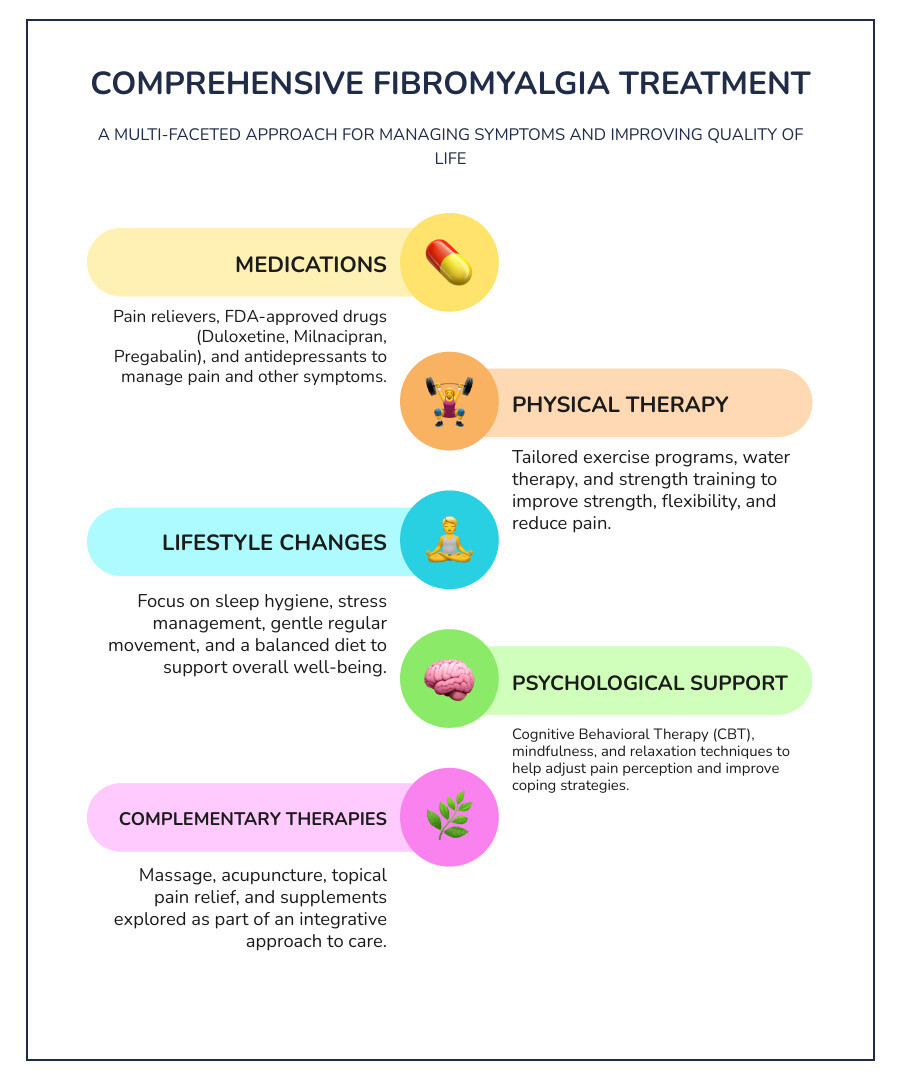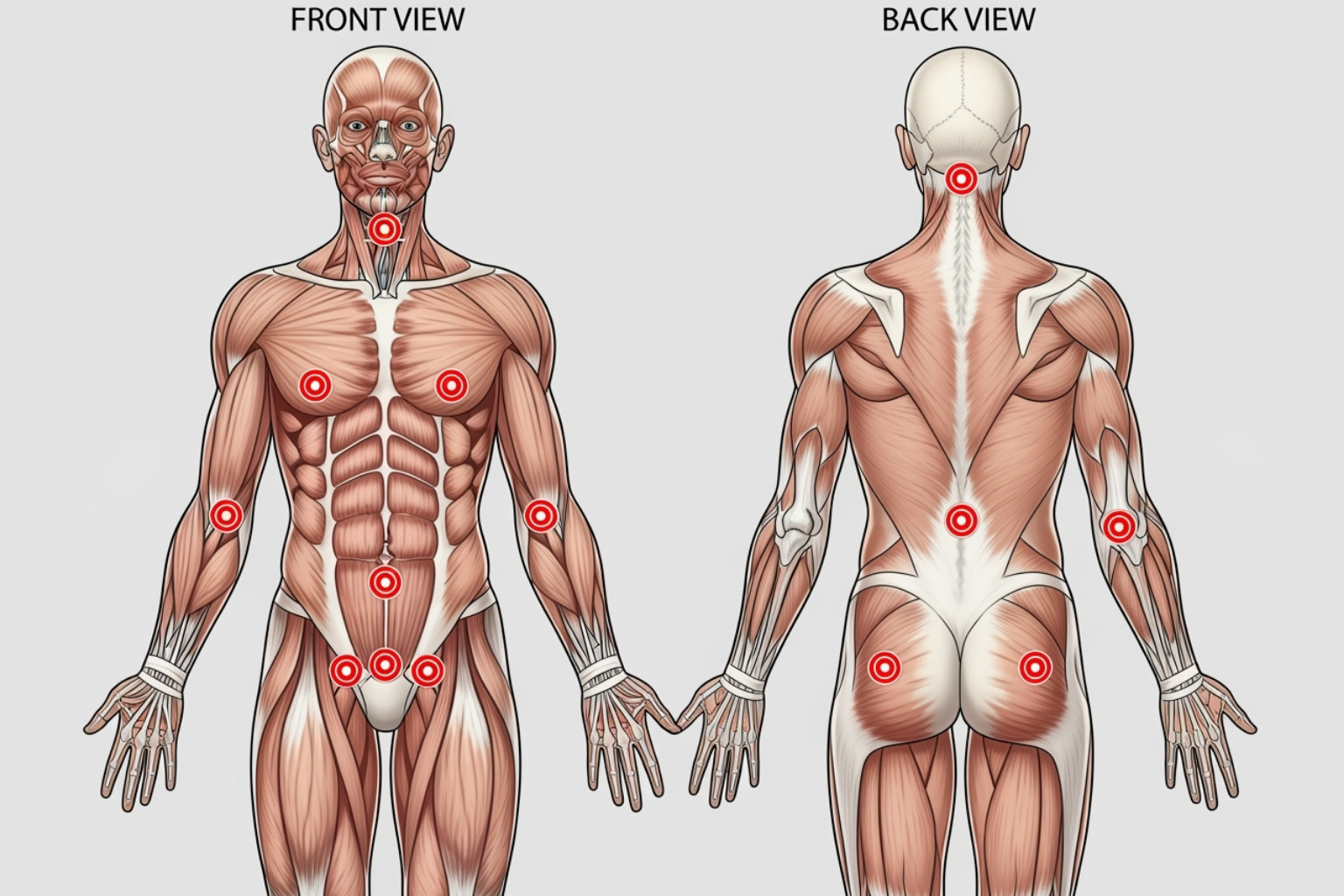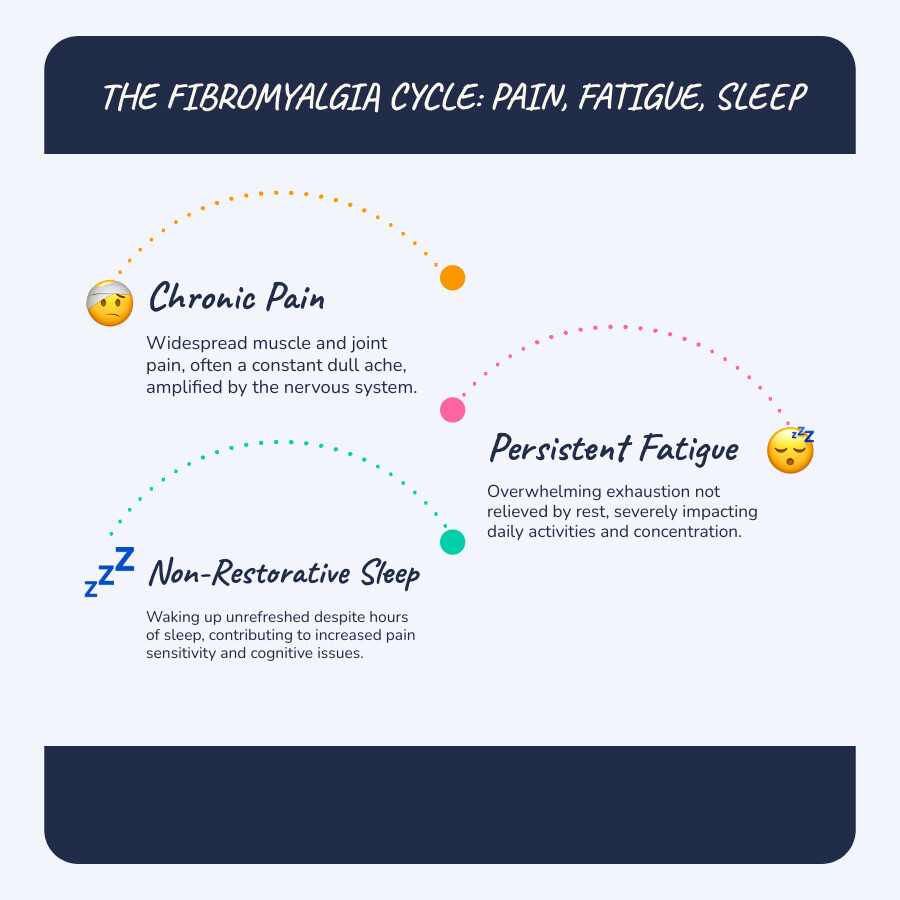Understanding Fibromyalgia and Your Treatment Options
Fibromyalgia treatment is a multi-faceted approach to manage chronic pain, reduce fatigue, and improve your quality of life. While there is no cure, effective treatment combines medications, lifestyle changes, and therapies custom to your needs.
Key Treatment Categories for Fibromyalgia:
- Medications: Pain relievers, FDA-approved drugs (Duloxetine, Milnacipran, Pregabalin), and antidepressants.
- Therapies: Physical therapy, Cognitive Behavioral Therapy (CBT), and occupational therapy.
- Lifestyle & Self-Care: Exercise, stress management, sleep hygiene, and diet.
- Complementary Approaches: Massage, acupuncture, and topical pain relief.
Fibromyalgia affects about 4 million adults in the U.S. (about 2% of the adult population), causing widespread pain, fatigue, and cognitive issues known as "fibro fog" (CDC, 2020). The condition is characterized by an amplified pain response in the nervous system, making it a real and recognized medical disorder that requires a comprehensive strategy.
Research shows that combining treatments—such as medications, therapies, and lifestyle changes—provides better results than any single approach (Mayo Clinic, 2023). For targeted relief from muscle and nerve pain without the systemic side effects of oral medications, topical solutions like Neuropasil can be an effective part of your plan. These creams work directly at the pain site for fast-acting comfort.
I'm Tony Enrico, and through my work with Neuropasil, I've seen how combining conventional medicine with effective topical pain management can significantly improve daily comfort for those with chronic pain. My goal is to help individuals manage pain symptoms with natural, fast-acting solutions.

Understanding Fibromyalgia: Symptoms, Causes, and Diagnosis
Fibromyalgia is a chronic condition where the nervous system amplifies pain signals, making you feel widespread pain even from gentle touch. It doesn't cause damage to muscles or joints, but it dramatically affects your quality of life. A key challenge is that standard tests often come back normal, yet the symptoms are very real.

Primary Symptoms That Require Treatment
Key symptoms often fluctuate in intensity, leading to periods known as "flare-ups."
- Widespread Pain: A constant, dull ache on both sides of the body, often described as deep, sharp, or burning.
- Persistent Fatigue: An overwhelming exhaustion that isn't relieved by sleep.
- Non-Restorative Sleep: Waking up feeling tired even after a full night's sleep.
- Cognitive Difficulties ("Fibro Fog"): Trouble with concentration, memory, and finding words.
- Other Common Symptoms: Chronic headaches or migraines, digestive issues like IBS, and heightened sensitivity to touch, temperature, and noise.
How Fibromyalgia is Diagnosed
Diagnosing fibromyalgia is a process of elimination, as there is no single test for it.
- Physical Examination and History: A doctor will assess your symptoms, particularly pain. A diagnosis requires widespread pain in at least four of five body regions that has lasted for three months or longer, along with other key symptoms like fatigue and cognitive issues (Mayo Clinic, 2023).
- Ruling Out Other Conditions: Blood tests and imaging scans are used to exclude other conditions with similar symptoms, such as rheumatoid arthritis or thyroid disorders.
An accurate diagnosis is crucial because it validates your experience and opens the door to effective fibromyalgia treatment. If you suspect you have fibromyalgia, consult a healthcare provider who takes your symptoms seriously. You can learn more about the diagnostic process from the Mayo Clinic.
While the exact cause is unknown, known risk factors include being a woman, having a family history of fibromyalgia, or having a rheumatic disease like lupus or rheumatoid arthritis (NIAMS, 2021). Symptoms can be triggered by physical trauma, surgery, infection, or significant psychological stress, though they sometimes develop gradually with no clear trigger.

Conventional Medical Fibromyalgia Treatment Options
Effective fibromyalgia treatment requires a partnership with your healthcare provider to create a flexible plan that adapts to your changing symptoms. The goal is to manage pain and fatigue, improve your quality of life, and help you return to activities you enjoy. Successful plans typically combine medications, physical therapy, and self-care strategies.
Medications for Fibromyalgia Treatment
Medications can help manage pain, fatigue, and sleep issues. While over-the-counter pain relievers like ibuprofen may offer mild relief, prescription medications are often more effective.
- FDA-Approved Medications: Three drugs are specifically approved for fibromyalgia treatment. Pregabalin (Lyrica) calms overactive nerves to reduce pain and improve sleep. Duloxetine (Cymbalta) and milnacipran (Savella) are antidepressants (SNRIs) that adjust brain chemicals to regulate pain and mood. You can find more information on FDA-approved drugs for fibromyalgia (FDA, 2014).
- Other Prescription Medications: Doctors may also prescribe low-dose tricyclic antidepressants (like amitriptyline) to improve sleep, other antidepressants (SSRIs), or gabapentin to reduce pain. Muscle relaxants can help with spasms and sleep.
- Important Note: Opioids are not recommended for fibromyalgia. Major health organizations, including the CDC, advise against their use for long-term fibromyalgia management, as research shows they are generally ineffective and carry significant risks, including dependence and potentially worsening pain over time (CDC, 2022).
Side effects like drowsiness, dizziness, or nausea are possible. Work with your doctor to find the right medication and dosage that maximizes benefits while minimizing side effects.
Physical and Occupational Therapy
Therapy is a cornerstone of treatment, empowering you with long-term management skills.
-
Physical Therapy (PT): A physical therapist will design a custom program to improve strength, flexibility, and stamina without causing flare-ups. This often includes:
- Gentle stretching to reduce stiffness. Get started with this Simple Stretches video.
- Low-impact aerobic exercise like walking, swimming, or cycling to reduce pain and boost energy.
- Water-based exercises, which are especially helpful as the water supports your body and reduces stress on joints.
-
Occupational Therapy (OT): An occupational therapist helps you manage daily life by teaching you strategies to conserve energy and reduce strain. This includes:
- Pacing activities to avoid the "boom-and-bust" cycle of overexertion followed by a crash.
- Adapting your work and home environment with ergonomic adjustments and labor-saving tools.
- Learning self-care techniques to perform daily tasks with less pain and fatigue. For more tips, see our guide on managing body aches.
Both therapies provide you with tools to regain control over your body and daily life.
The Role of Lifestyle and Self-Care in Managing Fibromyalgia
Your daily choices regarding exercise, stress, diet, and sleep are powerful tools in your fibromyalgia treatment plan. These self-management strategies are fundamental to living well with this condition and are strongly recommended by medical experts as part of a comprehensive treatment plan (Mayo Clinic, 2023).

The Power of Exercise and Movement Therapies
Though it may seem counterintuitive when you're in pain, regular, gentle movement is one of the most effective ways to manage fibromyalgia. Exercise boosts natural endorphins, improves sleep, and reduces fatigue.
- Recommended Activities: Start with low-impact exercises like walking, swimming, or water aerobics. Mind-body practices such as yoga, Tai Chi, and stretching are also excellent as they improve flexibility and calm the nervous system.
- The Golden Rule: Start low and go slow. Consistency is more important than intensity. A few short walks a week is better than one long session that triggers a flare-up. Listen to your body and adjust as needed. Our guide on how to reduce muscle soreness after workout offers helpful recovery tips.
Psychological and Behavioral Therapies
Chronic pain affects your mental and emotional well-being. Psychological therapies provide practical tools to cope with these challenges.
- Cognitive Behavioral Therapy (CBT): This therapy helps you identify and change negative thought patterns that can worsen pain perception. It also teaches coping skills and relaxation techniques.
- Stress Management: Since stress is a major flare-up trigger, techniques like deep breathing, mindfulness meditation, and progressive muscle relaxation are essential for calming the nervous system.
- Support Groups: Connecting with others who understand your experience provides invaluable emotional support and practical advice. You can find a support group near you to feel less isolated.
The Impact of Diet and Sleep Hygiene
What you eat and how you sleep have a profound impact on fibromyalgia symptoms.
- Diet: While there is no specific "fibromyalgia diet," many people benefit from an anti-inflammatory diet rich in fruits, vegetables, and healthy fats (like those in olive oil and salmon), while limiting processed foods, sugar, and red meat. Keeping a food diary can help identify personal trigger foods like gluten or dairy.
-
Sleep Hygiene: Poor sleep worsens pain, creating a vicious cycle. To improve sleep:
- Maintain a consistent sleep schedule, even on weekends.
- Create a cool, dark, and quiet bedroom.
- Avoid caffeine, alcohol, and screens for at least an hour before bed.
These lifestyle changes can significantly reduce symptom severity and improve your overall quality of life.
Exploring Complementary and Alternative Fibromyalgia Treatment
Many people find relief by integrating complementary therapies into their conventional fibromyalgia treatment plan. These approaches can serve as valuable additions to your wellness toolkit, but always discuss them with your healthcare provider first to ensure they are safe and appropriate for you.
Evidence-Based Alternative Therapies
Several alternative therapies are backed by research and patient experience.
- Massage and Myofascial Release: Gentle massage can release muscle tension, improve circulation, and provide temporary pain relief. Myofascial release targets the connective tissue (fascia) around muscles, which can become tight and painful in fibromyalgia.
- Acupuncture: This traditional Chinese medicine practice involves inserting thin needles at specific points to stimulate the release of endorphins (natural painkillers) and alter pain signals. A study in the Journal of Rehabilitative Medicine found that acupuncture provided lasting pain relief for many with fibromyalgia. You can read more about scientific research on integrative therapies for fibromyalgia.
- Light Therapy (Phototherapy): This emerging therapy uses different types of light to reduce muscle pain, improve mood, and regulate sleep cycles by influencing hormones and cellular healing.
Topical Solutions for Targeted Pain Relief
For localized pain flare-ups in areas like the shoulders or lower back, topical solutions offer a smart, targeted approach.
Unlike oral medications, topical creams work directly at the site of pain. This localized method provides relief for your "hot spots" without systemic side effects. A key ingredient, Menthol, creates a cooling sensation that acts as a counter-irritant, distracting your nervous system from pain signals. Many creams also include Aloe and Urea to soothe skin and improve absorption.
Because they are non-systemic, topical solutions are an excellent choice for the muscle soreness and nerve pain common in fibromyalgia.
At Neuropasil, our creams are formulated with Menthol, Aloe, and Urea to provide natural, fast-acting relief. Customers use Neuropasil for fibromyalgia, neuropathy, sciatica, and general aches and pains. To learn more, explore The Complete Guide to Nerve Pain Relief Creams and compare Muscle Pain Relief: Oral vs. Topical Options.
Supplements and Other Approaches
Certain supplements may help, but always consult your doctor before starting them.
- Vitamin D and Magnesium: Deficiencies in these nutrients are common in people with fibromyalgia. Some studies suggest that supplementation may help reduce pain and fatigue, but it's essential to consult your doctor before starting, as evidence is not definitive and high doses can be harmful (Cleveland Clinic, 2022).
- Natural and Herbal Remedies: While many seek natural options, it's crucial to research them and speak with your provider, as some can interact with medications. Our article on Natural Pain Relief Solutions covers evidence-based choices.
- Medical Marijuana: In regions where it is legal, some individuals report that it helps with pain, stiffness, and sleep. Research is ongoing.
Frequently Asked Questions about Fibromyalgia
Navigating a fibromyalgia diagnosis can bring up many questions. Here are clear, direct answers to some of the most common concerns.
Is there a cure for fibromyalgia?
Currently, there is no single cure for fibromyalgia. However, this does not mean there is no hope. Effective fibromyalgia treatment focuses on managing symptoms so you can live a full and active life. A combination of medications, therapies, and lifestyle changes can lead to significant symptom reduction and improved quality of life.
What is the long-term outlook for someone with fibromyalgia?
The long-term outlook is hopeful. While fibromyalgia is a chronic condition, it is manageable and does not damage your joints, muscles, or organs. Symptoms may fluctuate, with periods of flare-ups, but they can be controlled with a consistent treatment plan. Many people with fibromyalgia learn to manage their condition and continue to lead active, meaningful lives.
How can I actively participate in my fibromyalgia treatment plan?
You are the most important member of your treatment team. Taking an active role is key to successfully managing your condition. Here's how:
- Educate Yourself: Understand your condition to make informed decisions.
- Communicate Openly: Be honest with your healthcare team about your symptoms, concerns, and what is or isn't working.
- Track Symptoms and Triggers: Keep a journal to identify patterns related to pain, fatigue, sleep, stress, and diet. This helps tailor your treatment.
- Prioritize Self-Care: Make gentle exercise, consistent sleep, and stress management non-negotiable parts of your routine.
- Find Support: Join a support group to connect with others who understand. You can find a support group near you for encouragement and practical advice.
Understanding your triggers—like stress, weather changes, or illness—helps you manage flare-ups proactively. During these times, you may need to adjust your plan, perhaps by relying more on topical relief like Neuropasil for targeted comfort or focusing on relaxation techniques. If you experience persistent widespread pain, fatigue, and cognitive issues, seek medical attention. Early diagnosis and treatment are critical for long-term management.
Conclusion: Building Your Path to a Better Quality of Life
Living with fibromyalgia is challenging, but an effective fibromyalgia treatment plan is within reach. The most successful approach is a personalized one, combining conventional medicine with lifestyle adjustments, psychological support, and complementary therapies.
Think of your plan as a toolbox. You have different tools for different days—from physical therapy and stress management to targeted pain relief. Your active participation is the most critical factor. By tracking symptoms, communicating with your healthcare team, and committing to self-care, you take control of your health.
The long-term outlook is hopeful. Fibromyalgia does not cause progressive damage, and with the right strategies, you can lead a full, active life. For localized muscle and nerve pain, a topical cream like Neuropasil offers natural, fast-acting relief right where you need it. Powered by Aloe, Urea, and Menthol, it's a non-systemic option that complements your overall treatment plan.
Listen to your body, celebrate small victories, and remember you are not alone. You have the power to build a sustainable way of living that honors your body's needs and helps you thrive.
For more insights, explore Topical Pain Relief Creams, Gels, and Ointments Explained to find what might work best for you. You deserve to live your best life—fibromyalgia and all.
References
This guide draws on information from trusted medical organizations and peer-reviewed research to provide accurate, evidence-based information on fibromyalgia treatment.
- CDC (2020). Fibromyalgia. Centers for Disease Control and Prevention. Available at: https://www.cdc.gov/arthritis/basics/fibromyalgia.htm
- CDC (2022). CDC Clinical Practice Guideline for Prescribing Opioids for Pain — United States, 2022. Centers for Disease Control and Prevention. Available at: https://www.cdc.gov/mmwr/volumes/71/rr/rr7103a1.htm
- Cleveland Clinic (2022). Fibromyalgia. Available at: https://my.clevelandclinic.org/health/diseases/4844-fibromyalgia
- Mayo Clinic (2023). Fibromyalgia. Available at: https://www.mayoclinic.org/diseases-conditions/fibromyalgia/diagnosis-treatment/drc-20354785
- National Health Service (NHS) (2022). Treatment - Fibromyalgia. Available at: https://www.nhs.uk/conditions/fibromyalgia/treatment/
- National Institute of Arthritis and Musculoskeletal and Skin Diseases (NIAMS) (2021). Fibromyalgia. Available at: https://www.niams.nih.gov/health-topics/fibromyalgia
- Targino, R. A., et al. (2008). Acupuncture for fibromyalgia: a randomised controlled trial. Journal of Rehabilitative Medicine. Available at: https://medicaljournals.se/jrm/content/abstract/10.2340/16501977-0216
- U.S. Food & Drug Administration (FDA) (2014). Living with Fibromyalgia: Drugs Approved to Manage Pain. Available at: https://www.fda.gov/consumers/consumer-updates/living-fibromyalgia-drugs-approved-manage-pain














